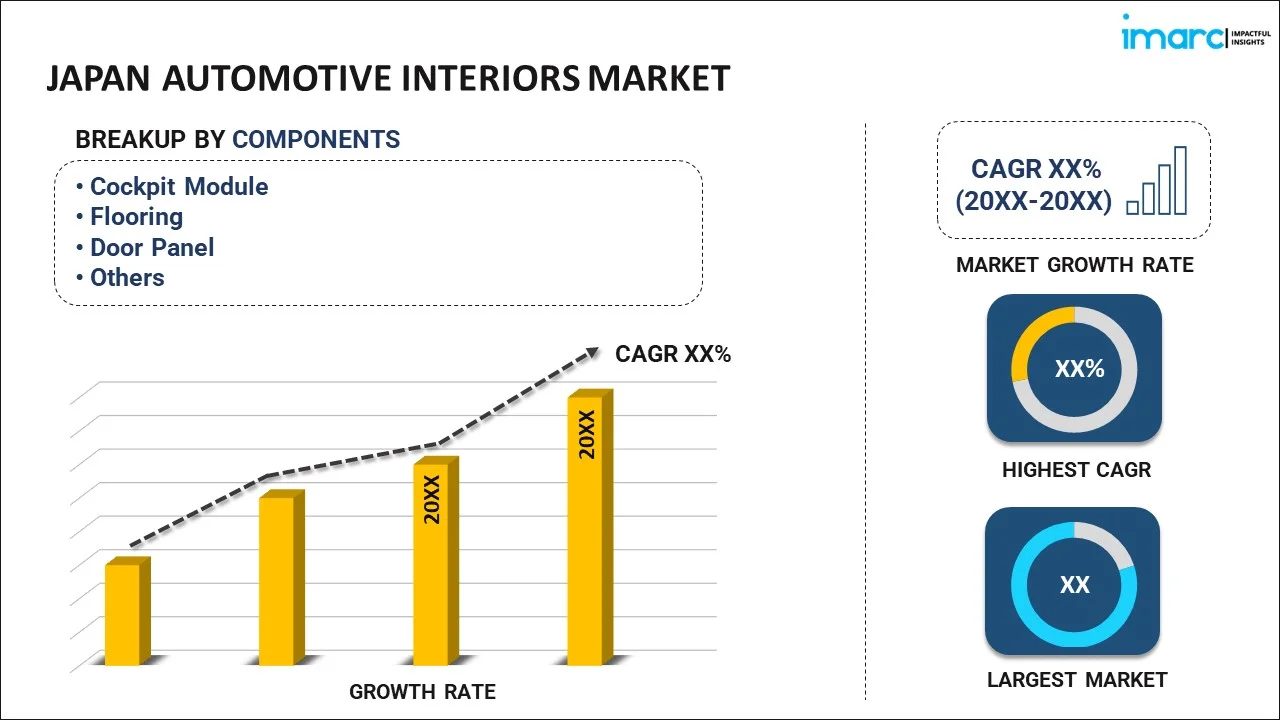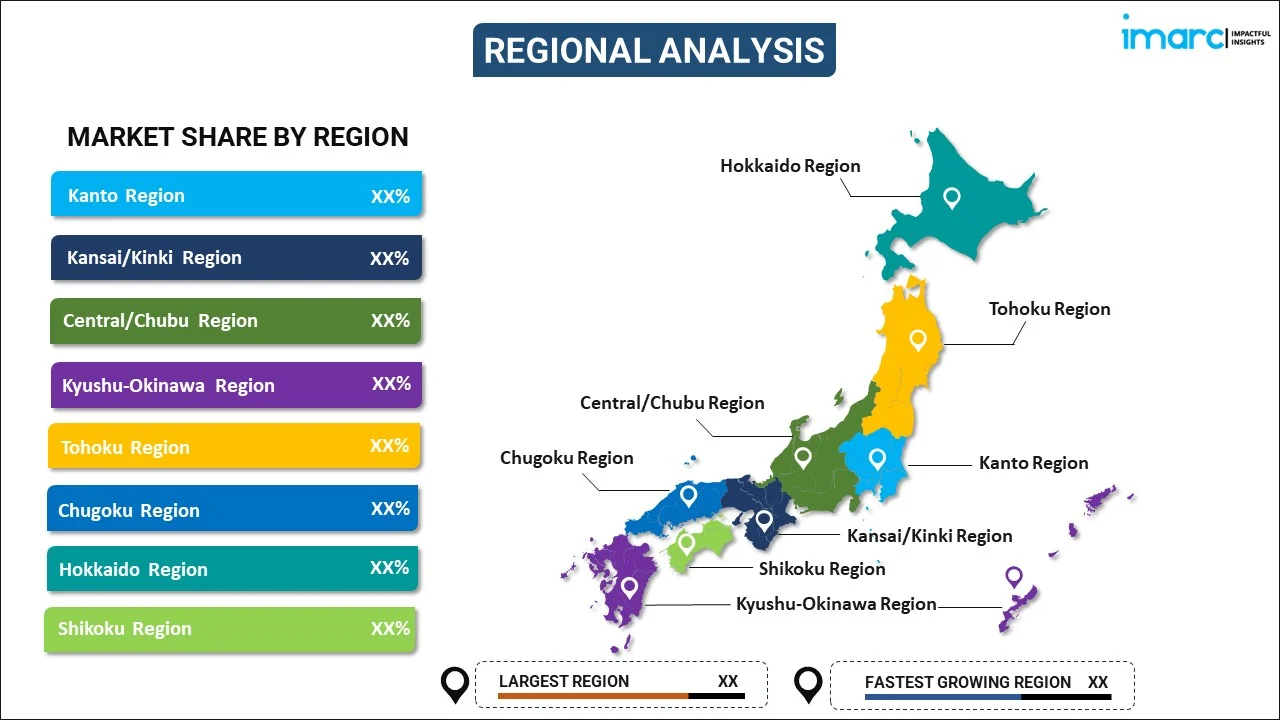
Japan Automotive Interiors Market Report by Component (Cockpit Module, Flooring, Door Panel, Automotive Seat, Interior Lighting, and Others), Material (Leather, Fabric, Vinyl, Wood, Glass Fiber Composite, Carbon Fiber Composite, Metal), Vehicle Type (Passenger Cars, Commercial Vehicles), and Region 2025-2033
Market Overview:
Japan automotive interiors market size is projected to exhibit a growth rate (CAGR) of 4.50% during 2025-2033. The rising number of vehicles with comfortable, aesthetically pleasing, and technologically advanced interiors, along with the widespread adoption of advanced infotainment systems, is primarily driving the market growth.
|
Report Attribute
|
Key Statistics
|
|---|---|
|
Base Year
|
2024 |
|
Forecast Years
|
2025-2033 |
|
Historical Years
|
2019-2024
|
| Market Growth Rate (2025-2033) | 4.50% |
Automotive interiors encompass a diverse array of integrated components that serve multiple purposes, including enhancing grip, ensuring comfort, improving visual appeal, and overall vehicle performance. These components comprise headliners, door panels, cockpit modules, dashboards, and seats, typically crafted from a range of materials such as fabrics, rubber, composites, plastics, and wood. In addition to this, to further elevate the quality and longevity of vehicles, additional interior trims and upholstery embellishments can be incorporated to prevent staining and provide an enhanced tactile experience within the vehicle. As a result, automotive interiors find extensive utilization in both passenger cars and commercial vehicles.
Japan Automotive Interiors Market Trends:
The Japan automotive interiors market is experiencing substantial growth, driven by several key factors. The expansion of the automotive sector has led to a heightened demand for luxurious vehicles equipped with premium features and advanced safety systems, which is primarily driving the market growth. Moreover, this surge in need can be attributed to increasing consumer security concerns, rising disposable incomes, rapid urbanization, and evolving preferences, particularly in developing regions, which is positively influencing the regional market. Additionally, the widespread integration of advanced technologies, including AI-enabled entertainment systems, hands-free connectivity, and GPS, is further fueling the market expansion. These technologies enhance the overall driving experience by enabling features such as hands-free phone calls, music streaming via mobile applications, and satellite radio access through touchscreen dashboards, which is acting as another significant growth-inducing factor. Furthermore, the adoption of bio-based plastics like bio-PET and bio-polyester in designing automotive interiors for reduced vehicle weight and increased flexibility is contributing to market growth. Apart from this, the trend of customization and strategic collaborations among key industry players to introduce innovative automotive interior solutions that cater to evolving consumer needs is expected to fuel the regional market in the coming years.
Japan Automotive Interiors Market Segmentation:
IMARC Group provides an analysis of the key trends in each segment of the market, along with forecasts at the country level for 2025-2033. Our report has categorized the market based on component, material, and vehicle type.
Component Insights:

- Cockpit Module
- Flooring
- Door Panel
- Automotive Seat
- Interior Lighting
- Others
The report has provided a detailed breakup and analysis of the market based on the component. This includes cockpit module, flooring, door panel, automotive seat, interior lighting, and others.
Material Insights:
- Leather
- Fabric
- Vinyl
- Wood
- Glass Fiber Composite
- Carbon Fiber Composite
- Metal
A detailed breakup and analysis of the market based on the material have also been provided in the report. This includes leather, fabric, vinyl, wood, glass fiber composite, carbon fiber composite, and metal.
Vehicle Type Insights:
- Passenger Cars
- Commercial Vehicles
The report has provided a detailed breakup and analysis of the market based on the vehicle type. This includes passenger cars and commercial vehicles.
Regional Insights:

- Kanto Region
- Kansai/Kinki Region
- Central/ Chubu Region
- Kyushu-Okinawa Region
- Tohoku Region
- Chugoku Region
- Hokkaido Region
- Shikoku Region
The report has also provided a comprehensive analysis of all the major regional markets, which include Kanto Region, Kansai/Kinki Region, Central/ Chubu Region, Kyushu-Okinawa Region, Tohoku Region, Chugoku Region, Hokkaido Region, and Shikoku Region.
Competitive Landscape:
The market research report has also provided a comprehensive analysis of the competitive landscape. Competitive analysis such as market structure, key player positioning, top winning strategies, competitive dashboard, and company evaluation quadrant has been covered in the report. Also, detailed profiles of all major companies have been provided. Some of the key players include:
- DaikyoNishikawa Corporation
- Kasai Kogyo Co. Ltd.
- Kotobukiya Fronte Co. Ltd.
- Sage Automotive Interiors Inc.
- Samvardhana Motherson Automotive Systems Group B.V.
- Tachi-S Co. Ltd.
- Toyota Boshoku Corporation (Toyota Motor Corporation)
- TS Tech Co. Ltd.
(Please note that this is only a partial list of the key players, and the complete list is provided in the report.)
Japan Automotive Interiors Market Report Coverage:
| Report Features | Details |
|---|---|
| Base Year of the Analysis | 2024 |
| Historical Period | 2019-2024 |
| Forecast Period | 2025-2033 |
| Units | US$ Million |
| Scope of the Report | Exploration of Historical Trends and Market Outlook, Industry Catalysts and Challenges, Segment-Wise Historical and Future Market Assessment:
|
| Components Covered | Cockpit Module, Flooring, Door Panel, Automotive Seat, Interior Lighting, Others |
| Materials Covered | Leather, Fabric, Vinyl, Wood, Glass Fiber Composite, Carbon Fiber Composite, Metal |
| Vehicle Types Covered | Passenger Cars, Commercial Vehicles |
| Regions Covered | Kanto Region, Kansai/Kinki Region, Central/ Chubu Region, Kyushu-Okinawa Region, Tohoku Region, Chugoku Region, Hokkaido Region, Shikoku Region |
| Companies Covered | DaikyoNishikawa Corporation, Kasai Kogyo Co. Ltd., Kotobukiya Fronte Co. Ltd., Sage Automotive Interiors Inc., Samvardhana Motherson Automotive Systems Group B.V., Tachi-S Co. Ltd., Toyota Boshoku Corporation (Toyota Motor Corporation), TS Tech Co. Ltd., etc. (Please note that this is only a partial list of the key players, and the complete list is provided in the report.) |
| Customization Scope | 10% Free Customization |
| Report Price and Purchase Option | Single User License: US$ 3699 Five User License: US$ 4699 Corporate License: US$ 5699 |
| Post-Sale Analyst Support | 10-12 Weeks |
| Delivery Format | PDF and Excel through Email (We can also provide the editable version of the report in PPT/Word format on special request) |
Key Questions Answered in This Report:
- How has the Japan automotive interiors market performed so far and how will it perform in the coming years?
- What has been the impact of COVID-19 on the Japan automotive interiors market?
- What is the breakup of the Japan automotive interiors market on the basis of component?
- What is the breakup of the Japan automotive interiors market on the basis of material?
- What is the breakup of the Japan automotive interiors market on the basis of vehicle type?
- What are the various stages in the value chain of the Japan automotive interiors market?
- What are the key driving factors and challenges in the Japan automotive interiors?
- What is the structure of the Japan automotive interiors market and who are the key players?
- What is the degree of competition in the Japan automotive interiors market?
Key Benefits for Stakeholders:
- IMARC’s industry report offers a comprehensive quantitative analysis of various market segments, historical and current market trends, market forecasts, and dynamics of the Japan automotive interiors market from 2019-2033.
- The research report provides the latest information on the market drivers, challenges, and opportunities in the Japan automotive interiors market.
- Porter's five forces analysis assist stakeholders in assessing the impact of new entrants, competitive rivalry, supplier power, buyer power, and the threat of substitution. It helps stakeholders to analyze the level of competition within the Japan automotive interiors industry and its attractiveness.
- Competitive landscape allows stakeholders to understand their competitive environment and provides an insight into the current positions of key players in the market.
Need more help?
- Speak to our experienced analysts for insights on the current market scenarios.
- Include additional segments and countries to customize the report as per your requirement.
- Gain an unparalleled competitive advantage in your domain by understanding how to utilize the report and positively impacting your operations and revenue.
- For further assistance, please connect with our analysts.
 Inquire Before Buying
Inquire Before Buying
 Speak to an Analyst
Speak to an Analyst
 Request Brochure
Request Brochure
 Request Customization
Request Customization




.webp)




.webp)












